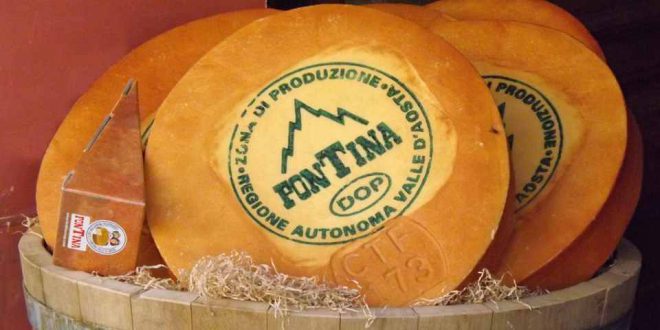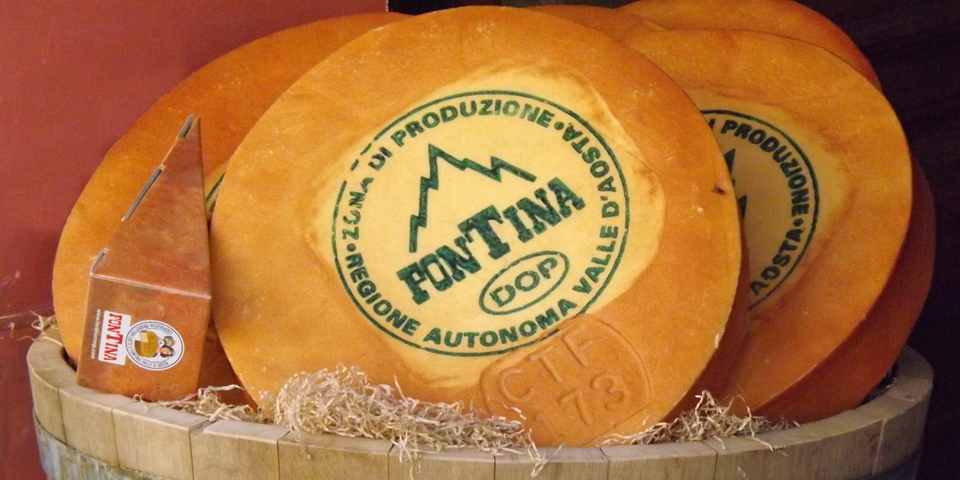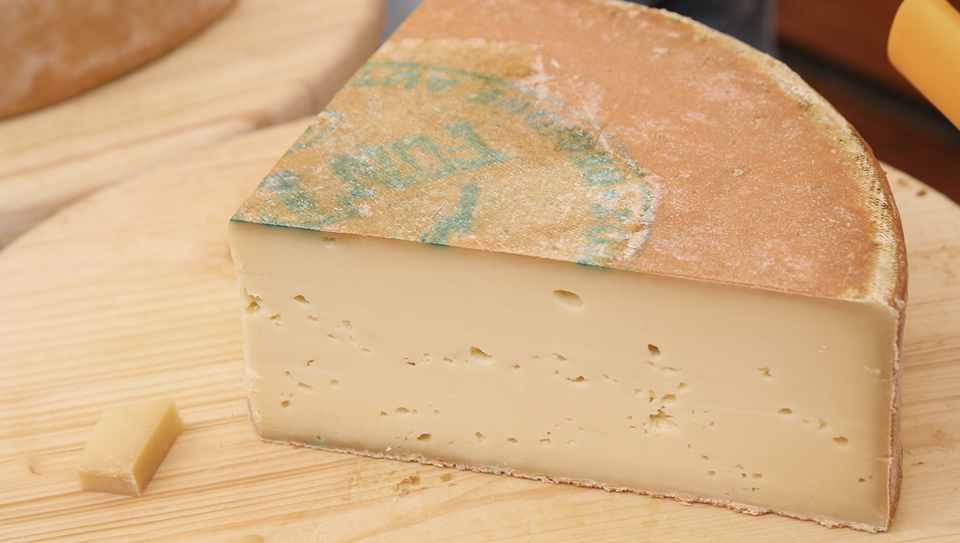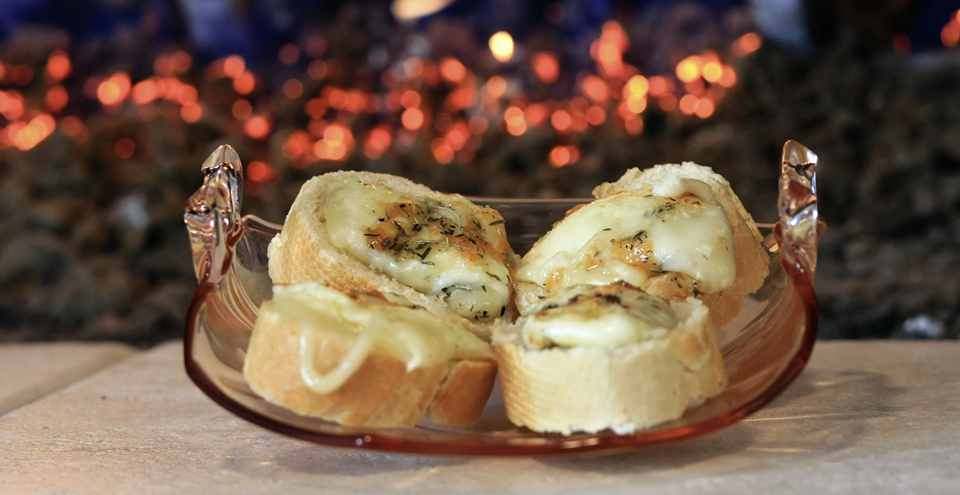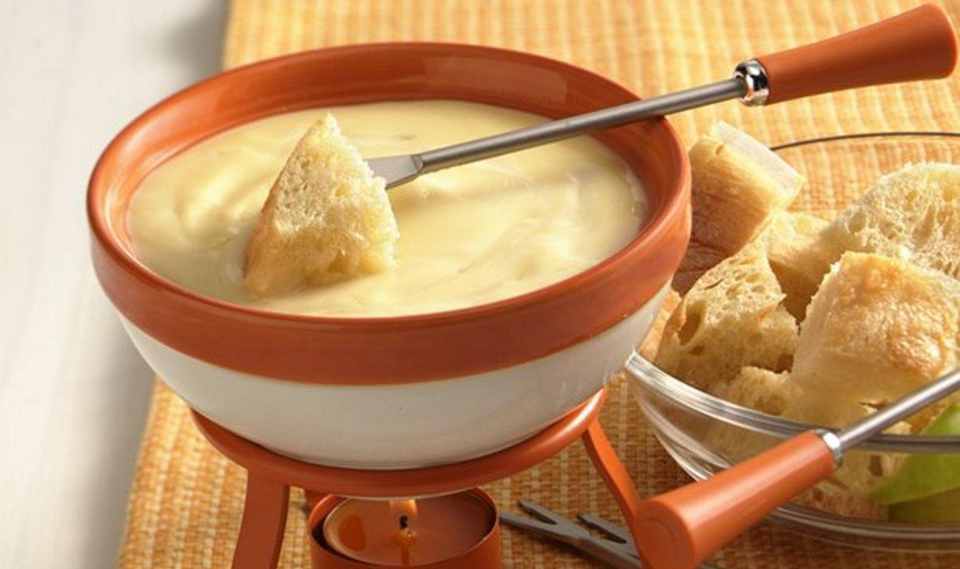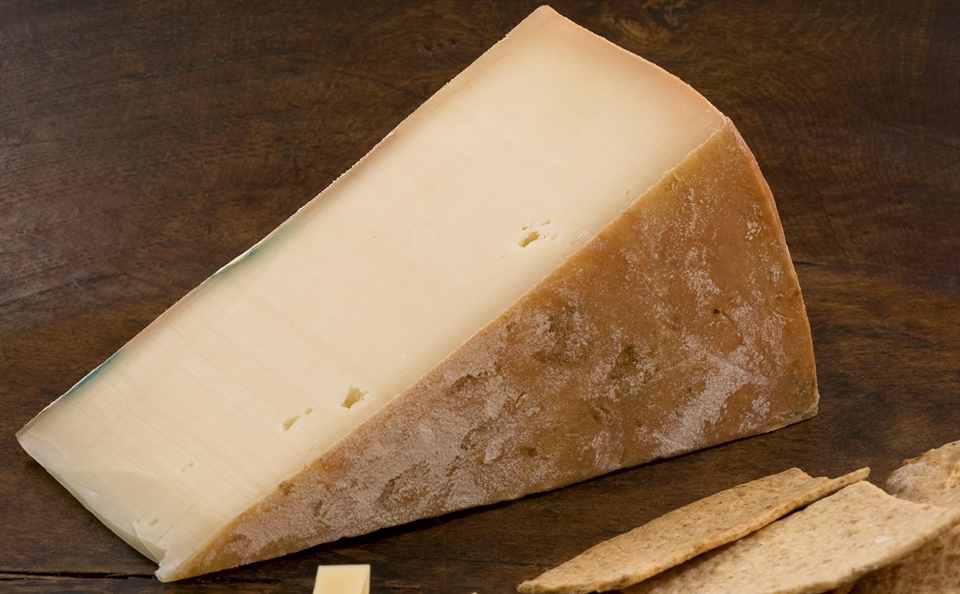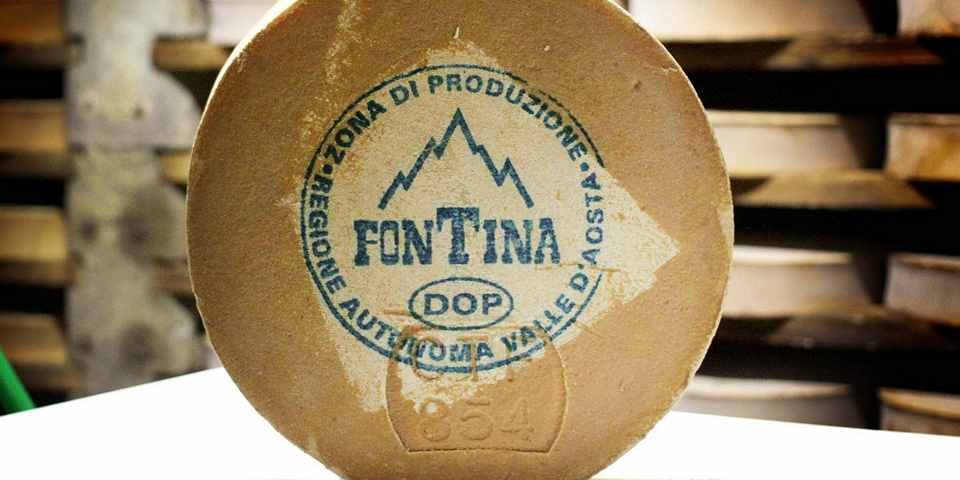Fontina is not the name of a passionate Italian woman, but rather the name of another esteemed cheese elder. It was born in the Valle d’Aosta region and has survived to this day in virtually the same form. This cheese notably differs in taste characteristics from its Alpine counterparts. We won’t keep you in suspense for long and invite you to get to know it better.
Page Contents
History
The first mention of Fontina is not found in official documents like most cheeses. It was depicted in a fresco in the 15th century at the Issogne Castle in the Valle d’Aosta region. The fresco portrayed a workshop with a large number of cheese heads.
The name “Fontina” is believed to originate from the area called Fontin, where its recipe was developed. Other historians consider the village of Fontinaz as the progenitor of the cheese name. A third version is based on the old French term “fontis” or “fondis,” which was used to denote the ability of products to melt when heated.
The term “Fontina” for the cheese was first mentioned in 1477. The physician Pantaleone da Confienza wrote about it in his treatise “Summa Lacticinorum.”
- Read also: types of Italian cheeses from A to Z
The first classification dates back to 1887 when a dairy report described the product as “Le Fontine di Val d’Aosta.” In the 1930s and 1940s, the Italian Ministry of Agriculture and Forestry carried out its second classification.
In 1955, by decree of the President of the Republic, Fontina was included in the category of products with a controlled designation of origin (DOC). This marked the beginning of comprehensive research on the cheese.
In 1957, the producers convened the Consortium for the Control of Production and Sale of the cheese. In the first year, 75,000 cheese heads were sold. After 10 years, it reached 150,000, and by the late 1980s, sales figures reached 300,000. In 1995, Fontina Valdostana was granted protected designation of origin (DOP) by the decision of the European Union.
Technology
The production of Fontina cheese and its raw materials takes place exclusively within the region of Valle d’Aosta. The milk is obtained only from specific breeds of cows (Valdostana Pezzata rossa, Valdostana Pezzata near) that graze on high-altitude pastures during the summer or feed on local hay during the winter.
To prepare the cheese, whole milk from a single milking is used. After milking, the milk is processed within 2 hours to preserve all its beneficial properties and aroma. Before coagulation, the raw milk undergoes heat treatment at a temperature above 36 degrees Fahrenheit (2 degrees Celsius).
Coagulation occurs in copper or steel vats by adding calf rennet and heating it to 34-36 degrees Fahrenheit (1-2 degrees Celsius) for a minimum of 40 minutes. The curd is then broken down into granules the size of corn kernels by the cheesemaker.
The vats are heated to 46-48 degrees Fahrenheit (8-9 degrees Celsius) until the cheesemaker determines that the whey is transparent enough. The curd is then left to rest for at least 10 minutes. Afterwards, the curd is manually transferred to forms lined with cloth to allow the liquid to drain. During the 24-hour pressing stage, the cheese heads are marked (with a manufacturer code and production date) using a casein plate, which later becomes part of the rind. The cheese is brined by immersing it in salted water for 12 hours.
The maturation of Fontina cheese takes place in caves carved into the rocks. These spaces maintain a temperature of approximately 50 degrees Fahrenheit (10 degrees Celsius) and a humidity of 90% year-round.
The aging process lasts for more than 80 days. During this time, the cheese heads are rubbed, turned, and dry-salted. Once the quality of the cheese heads is confirmed by the Consortium’s experts, the matured cheese is marked with a logo (“Fontina DOP” with a stylized image of mountains) using a stamp.
The production of one Fontina cheese requires approximately 100 liters of milk. Currently, around 400,000 heads are produced annually.
Характеристики
Fontina is a semi-hard cheese of medium maturity. It has an elastic, soft texture with a small amount of unevenly distributed eyes. It can range in color from ivory to straw. It is characterized by a distinct sweet taste with nutty undertones, which becomes more pronounced as it ages.
The ideal weight of a wheel ranges from 7.5 to 12 kg (16.5 to 26.5 lbs). It has a cylindrical shape with slightly concave sides, measuring 7-10 cm (2.8-3.9 inches) in height, and flat surfaces with a diameter of 35-45 cm (13.8-17.7 inches). The rind is brown, thin, and compact. The intensity of its color increases as it matures.
The fat content in the dry matter is 45%. Fontina stands out for its high content of live lactic acid cultures. In Italy, there are variations such as “Fontinella,” “Fontal,” and “Fontella” that do not fall under the DOP (Protected Designation of Origin) category. These variations are much milder compared to the original product.
With what to eat, how to store and what to replace
Fontina has gained wide popularity not only in Italian cuisine but also among chefs worldwide. It is enjoyed on its own as part of a cheese platter and pairs perfectly with fresh bread or croutons. Due to its low melting point (60 degrees Celsius/140 degrees Fahrenheit), it is ideal for hot sandwiches and pizza.
Grated Fontina is added to soups, dumplings, porridge, and meat dishes. It is used to season roasted vegetables and salads. It is unrivaled in dishes like polenta and risotto. The cheese is considered a definitive leader in fondue preparation.
As for alcoholic beverages, the best pairing for Fontina would be red wines such as Nebbiolo and Merlot.
It should be stored in the least cold part of the refrigerator, wrapped in plastic wrap. However, if you’re a perfectionist, you can wrap Fontina in a damp linen cloth and place it in a glass vacuum container. The product should be taken out at least half an hour before serving.
What can you substitute Fontina with in recipes? This is a subjective question because while substitutions can be made easily, there will inevitably be a loss of the dish’s distinctive flavor. Alternative cheeses include Russian cheese, Dutch cheese, “King Arthur,” Swiss, and Maasdam.
Now, let’s not overlook the recipe for the famous cheese fondue.
Fontina Fondue Recipe
To make Fontina fondue, you will need 20 minutes and just a few ingredients:
- 200 g (7 oz) of Fontina cheese;
- 125 g (4.4 oz) of whole milk;
- 15 g (1 tbsp) of butter;
- 2 egg yolks.
Preparation: Slice the cheese into thin slices and place them in a narrow, tall pot or a special fondue container. Pour milk over the cheese and leave it in the refrigerator for several hours. Heat the prepared mixture in a double boiler, add butter and egg yolks. Continue heating until you achieve a smooth, thick cream. You can season the dish with salt and pepper to taste, but keep in mind that the cheese itself is already quite salty. Fondue is typically enjoyed by dipping pieces of bread or favorite fruits into it.
Caloric Value and Benefits
Like all cheeses made from whole milk, Fontina cheese has a high caloric value of 343 kcal per 100g. It contains:
- Protein: 27g
- Fat: 28g
- Carbohydrates: 0g
Despite the fact that most of the cheese’s fat content is saturated, its cholesterol content is not excessively high, at 80mg per 100g. The cholesterol content tends to decrease in cheeses made during the “green pastures” period (May to October). Additionally, the concentration of unsaturated fatty acids (omega-3 and omega-6) increases, which can improve the condition of hair and nails, suppress inflammatory processes, and prevent cardiovascular and neurological diseases.
Fontina cheese is characterized by a high protein content, including essential amino acids. It has a lower salt content compared to other types of cheese, while its mineral content is significant. 100g of the product covers 86% of the daily calcium requirement and 68% of the phosphorus requirement. These are essential components for the health of bones, muscles, teeth, and skin, helping to prevent osteoporosis.
A serving of cheese (50g) provides 26% of the recommended daily intake of vitamin A, which is crucial for sharp vision and firm skin.
In terms of live lactic acid bacteria content, Fontina cheese is comparable to kefir or yogurt. Therefore, it is particularly valuable for those with digestive issues.
Due to its nutritional properties, Fontina cheese is an excellent product for people of all ages and lifestyles. It can enrich the diet of children, pregnant women, athletes, and the elderly. It can also aid in the recovery of individuals weakened by illness or those experiencing a lack of appetite.
Price in Italy
Finding Fontina cheese in Italy is relatively easy. This beloved Italian cheese can be purchased at prices ranging from 13 to 18 euros per kilogram for the original product.
With that, our introduction to this long-lasting cheese comes to an end. We hope you have found everything you were looking for and more. Live independently, love wholeheartedly, have diverse experiences, and remember: “Once you try fondue, don’t say you won’t go to Italy for Fontina!”
Interesting Facts about Fontina Cheese
- Fontina cheese, hailing from the picturesque Aosta Valley in Italy, has a history dating back over 800 years. Its traditional production methods have been passed down through generations, ensuring the preservation of its authentic flavors and textures.
- The unique microclimate and rich alpine pastures of the Aosta Valley contribute to the exceptional quality of Fontina cheese. The cows graze on herbs, flowers, and grasses, imparting a distinctive terroir to the cheese and enhancing its flavor profile.
- Fontina cheese is made exclusively from raw cow’s milk, further emphasizing its connection to the land and its commitment to natural and traditional cheese-making practices. This dedication to quality and craftsmanship shines through in every bite.
- With its creamy and supple texture, Fontina cheese is a true delight to the taste buds. It boasts a rich and nutty flavor with hints of earthiness, making it a versatile cheese that can be enjoyed on its own or incorporated into a wide range of dishes.
- Fontina cheese is a beloved ingredient in Italian cuisine, particularly in the classic dish known as “Fonduta.” This luscious, melted cheese fondue showcases Fontina’s exceptional melting qualities and is often served with crusty bread, vegetables, or cured meats.
- When melted, Fontina cheese develops a velvety smoothness and a delectable aroma that enhances any dish. Its ability to maintain its structure while melting makes it an ideal choice for gourmet grilled cheese sandwiches, savory tarts, and creamy risottos.
- Fontina cheese pairs exceptionally well with robust red wines such as Barolo or Nebbiolo. The cheese’s nuanced flavors harmonize with the wine’s depth, creating a delightful culinary experience that showcases the best of Italian flavors.
 Italy for me From Italy with love
Italy for me From Italy with love

